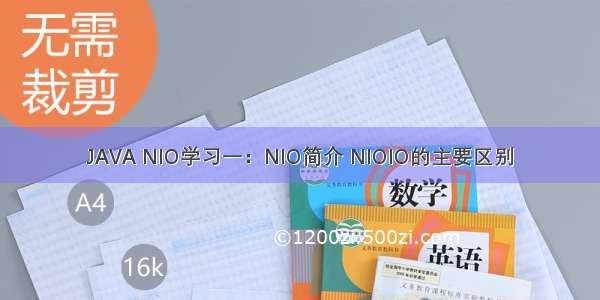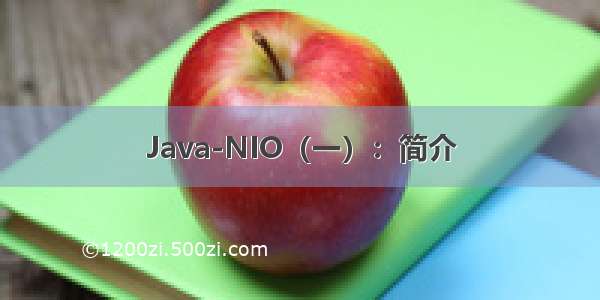
一、NIO基本简介
NIO(New lO)也有人称之为java non-blocking lO是从Java 1.4版本开始引入的一个新的IO API,可以替代标准的Java lO API。NIO与原来的IO有同样的作用和目的,但是使用的方式完全不同,NIO支持面向缓冲区的、基于通道的IO操作。NIO将以更加高效的方式进行文件的读写操作。NIO可以理解为非阻塞IO,传统的IO的read和write只能阻塞执行,线程在读写IO期间不能干其他事情,比如调用socket.read()时,如果服务器一直没有数据传输过来,线程就一直阻塞,而NIO中可以配置socket为非阻塞模式。
NIO相关类都被放在java.nio包及子包下,并且对原java.io包中的很多类进行改写。NIO有三大核心部分:Channel(通道),Buffer(缓冲区), Selector(选择器)Java NlO的非阻塞模式,使一个线程从某通道发送请求或者读取数据,但是它仅能得到目前可用的数据,如果目前没有数据可用时,就什么都不会获取,而不是保持线程阻塞,所以直至数据变的可以读取之前,该线程可以继续做其他的事情。非阻塞写也是如此,一个线程请求写入一些数据到某通道,但不需要等待它完全写入,这个线程同时可以去做别的事情。通俗理解:NIO是可以做到用一个线程来处理多个操作的。假设有1000个请求过来,根据实际情况,可以分配20或者80个线程来处理。不像之前的阻塞IO那样,非得分配1000个。
二、NIO 与 BIO的比较
BIO以流的方式处理数据,而NIO以块的方式处理数据,块I/O的效率比流IO高很多BIO是阻塞的,NIO则是非阻塞的BlO基于字节流和字符流进行操作,而NIO基于Channel(通道)和Buffer(缓冲区)进行操作,数据总是从通道读取到缓冲区中,或者从缓冲区写入到通道中。Selector(选择器)用于监听多个通道的事件(比如:连接请求,数据到达等),因此使用单个线程就可以监听多个客户端通道NIO可以先将数据写入到缓冲区,然后再有缓冲区写入通道,因此可以做到同步非阻塞。
BIO则是面向的流,读写数据都是单向的。因此是同步阻塞。
三、NIO 三大核心原理示意图
NIO有三大核心部分:Channel(通道),Buffer(缓冲区),Selector(选择器)
Buffer(缓冲区)
缓冲区本质上是一块可以写入数据,然后可以从中读取数据的内存。这块内存被包装成NIO Buffer对象,并提供了一组方法,用来方便的访问该块内存。相比较直接对数组的操作,Buffer APl更加容易操作和管理。
Channel(通道)
Java NIO的通道类似流,但又有些不同:既可以从通道中读取数据,又可以写数据到通道。但流的(input或output)读写通常是单向的。通道可以非阻塞读取和写入通道,通道可以支持读取或写入缓冲区,也支持异步地读写。
Selector(选择器)
Selector是一个ava NIO组件,可以能够检查一个或多个NIO通道,并确定哪些通道已经准备好进行读取或写入。这样,一个单独的线程可以管理多个channel,从而管理多个网络连接,提高效率
每个channel都会对应一个 Buffer一个线程对应Selector ,一个Selector对应多个channel(连接)程序切换到哪个channel是由事件决定的Selector 会根据不同的事件,在各个通道上切换Buffer 就是一个内存块,底层是一个数组数据的读取写入是通过 Buffer完成的,BlO中要么是输入流,或者是输出流,不能双向,但是NIO的Buffer是可以读也可以写。Java NIO系统的核心在于:通道(Channel)和缓冲区(Buffer)。通道表示打开到lO设备(例如:文件、套接字)的连接。若需要使用NIO系统,需要获取用于连接IO设备的通道以及用于容纳数据的缓冲区。然后操作缓冲区,对数据进行处理。简而言之,Channel负责传输,Buffer负责存取数据
四、NIO核心一:缓存区 (Buffer)
缓冲区(Buffer)一个用于特定基本数据类型的容器。由 java.nio 包定义的,所有缓冲区 都是 Buffer 抽象类的子类.。Java NIO 中的Buffer 主要用于与 NIO 通道进行 交互,数据是从通道读入缓冲区,从缓冲区写入通道中的
Buffer 类及其子类:
Buffer就像一个数组,可以保存多个相同类型的数据。根据 数据类型不同 ,有以下 Buffer 常用子类:
ByteBufferCharBufferShortBufferIntBufferLongBufferFloatBufferDoubleBuffer
上述 Buffer 类他们都采用相似的方法进行管理数据,只是各自 管理的数据类型不同而已。都是通过如下方法获取一个 Buffer 对象:
static XxxBuffer allocate(int capacity) :创建一个容量为capacity 的 XxxBuffer 对象
缓冲区的基本属性 Buffer 中的重要概念:
容量 (capacity) :作为一个内存块,Buffer具有一定的固定大小, 也称为"容量",缓冲区容量不能为负,并且创建后不能更改。
限制 (limit):表示缓冲区中可以操作数据的大小 (limit 后数据不能进行读写)。缓冲区的限制不能 为负,并且不能大于其容量。 写入模式,限制等于 buffer的容量。读取模式下,limit等于写入的数据量。
位置 (position):下一个要读取或写入的数据的索引。 缓冲区的位置不能为 负,并且不能大于其限制
标记 (mark)与重置 (reset):标记是一个索引, 通过 Buffer 中的 mark() 方法 指定 Buffer 中一个 特定的 position,之后可以通过调用 reset() 方法恢 复到这 个 position.
标记、位置、限制、容量遵守以下不变式:0 <= mark <= position <= limit <= capacity
Buffer常见方法:
Buffer clear() :清空缓冲区并返回对缓冲区的引用Buffer flip() :为 将缓冲区的界限设置为当前位置, 并将当前位置重置为 0int capacity() :返回 Buffer 的 capacity 大小boolean hasRemaining():判断缓冲区中是否还有元素int limit() :返回 Buffer 的界限(limit) 的位置Buffer limit(int n)将设置缓冲区界限为 n, 并返回一个具有新 limit 的缓冲区对象Buffer mark():对缓冲区设置标记int position() :返回缓冲区的当前位置 positionBuffer position(int n) :将设置缓冲区的当前位置为 n, 并返回修改后的 Buffer 对象int remaining() :返回 position 和 limit 之间的元素个数Buffer reset() :将位置 position 转到以前设置的mark 所在的位置Buffer rewind() :将位置设为为 0, 取消设置的 mark
缓冲区的数据操作 Buffer 所有子类提供了两个用于数据操作的方法:
get() :读取单个字节get(byte[] dst):批量读取多个字节到 dst 中get(int index):读取指定索引位置的字节(不会移动 position)放到入数据到Buffer中put(byte b):将给定单个字节写入缓冲区的当前位置put(byte[] src):将 src 中的字节写入缓冲区的当前位置put(int index, byte b):将指定字节写入缓冲区的索引 位置(不会移动 position)
使用Buffer读写数据一般遵循以下四个步骤:
写入数据到Buffer调用flip()方法,转换为读取模式从Buffer中读取数据调用buffer.clear()方法或者pact()方 法清除缓冲区
package com.kgf.kgfjavalearning.io.nio;import org.junit.Test;import java.nio.ByteBuffer;/**** Buffer测试类*/public class TestBuffer {@Testpublic void test1(){//1. 分配一个指定大小的缓冲区ByteBuffer buf = ByteBuffer.allocate(1024);System.out.println("-----------------allocate()----------------");System.out.println(buf.position());// 0: 表示当前的位置为0System.out.println(buf.limit());// 1024: 表示界限为1024,前1024个位置是允许我们读写的System.out.println(buf.capacity());//1024:表示容量大小为1024//2. 利用 put() 存入数据到缓冲区中System.out.println("-----------------put()----------------");String str = "itheima";buf.put(str.getBytes());System.out.println(buf.position());// 7表示下一个可以写入的位置是7,因为我们写入的字节是7个,从0开始已经写了7个,位置为8的position为7System.out.println(buf.limit());// 1024:表示界限为1024,前1024个位置是允许我们读写的System.out.println(buf.capacity());//1024:表示容量大小为1024//3. 切换读取数据模式System.out.println("-----------------flip()----------------");buf.flip();System.out.println(buf.position());// 0: 读取的起始位置为0System.out.println(buf.limit());// 7: 表示界限为7,前7个位置有数据可以读取System.out.println(buf.capacity());// 1024:表示容量大小为1024//4. 利用 get() 读取缓冲区中的数据System.out.println("-----------------get()----------------");byte[] dst = new byte[buf.limit()];//创建一个界限为limit大小的字节数组buf.get(dst);//批量将limit大小的字节写入到dst字节数组中System.out.println(new String(dst, 0, dst.length));//结果为itheimaSystem.out.println(buf.position());//7: 读取的位置变为7,因为前面的7个字节数据已经全部读取出去,下一个可读取的位置为7,从0开始的System.out.println(buf.limit());//7: 可读取的界限大小为7System.out.println(buf.capacity());// 1024: 表示容量大小为1024//5. rewind() : 可重复读System.out.println("-----------------rewind()----------------");buf.rewind();// 将位置设为为 0,从头开始读取System.out.println(buf.position());// 0System.out.println(buf.limit());// 7System.out.println(buf.capacity());// 1024//6. clear() : 清空缓冲区. 但是缓冲区中的数据依然存在,但是处于“被遗忘”状态System.out.println("-----------------clear()----------------");buf.clear();System.out.println(buf.position());// 0System.out.println(buf.limit());// 1024System.out.println(buf.capacity());// 1024System.out.println((char)buf.get());//i}@Testpublic void test2(){String str = "itheima";ByteBuffer buf = ByteBuffer.allocate(1024);buf.put(str.getBytes());// 将str写入到buf缓冲区中buf.flip();//转换为读模式byte[] dst = new byte[buf.limit()];//定义一个字节数组buf.get(dst, 0, 2);//将前2个字节批量写入到dst字节数组中System.out.println(new String(dst, 0, 2));//打印结果为itSystem.out.println(buf.position());//当前下一个读取的位置为2//mark() : 标记buf.mark();buf.get(dst, 2, 2);//从第3个位置开始将2个字节批量写入到dst字节数组中System.out.println(new String(dst, 2, 2));//打印结果为heSystem.out.println(buf.position());// 当前下一个读取的位置为4//reset() : 恢复到 mark 的位置buf.reset();System.out.println(buf.position());// 2//判断缓冲区中是否还有剩余数据if(buf.hasRemaining()){//获取缓冲区中可以操作的数量System.out.println(buf.remaining());// 5: 返回 position 和 limit 之间的元素个数}}@Testpublic void test3(){//分配直接缓冲区ByteBuffer buf = ByteBuffer.allocateDirect(1024);System.out.println(buf.isDirect());}}直接与非直接缓冲区:
byte byffer可以是两种类型,一种是基于直接内存(也就是非堆内存);另一种是非直接内存(也就是堆内存)。对于直接内存来说,JVM将会在IO操作上具有更高的性能,因为它
直接作用于本地系统的IO操作
。而非直接内存,也就是堆内存中的数据,如果要作IO操作,会先从本进程内存复制到直接内存,再利用本地IO处理。从数据流的角度,非直接内存是下面这样的作用链:
本地IO-->直接内存-->非直接内存-->直接内存-->本地IO
而直接内存是:
本地IO-->直接内存-->本地IO
很明显,在做IO处理时,比如网络发送大量数据时,直接内存会具有更高的效率。直接内存使用allocateDirect创建,但是它比申请普通的堆内存需要耗费更高的性能。不过,这部分的数据是在JVM之外的,因此它不会占用应用的内存。所以呢,当你有很大的数据要缓存,并且它的生命周期又很长,那么就比较适合使用直接内存。只是一般来说,如果不是能带来很明显的性能提升,还是推荐直接使用堆内存。字节缓冲区是直接缓冲区还是非直接缓冲区可通过调用其 isDirect() 方法来确定。
使用场景
有很大的数据需要存储,它的生命周期又很长适合频繁的IO操作,比如网络并发场景
五、NIO核心二:通道(Channel)
1、通道Channe概述
通道(Channel):由 java.nio.channels 包定义 的。Channel 表示 IO 源与目标打开的连接。 Channel 类似于传统的“流”。只不过 Channel本身不能直接访问数据,Channel 只能与 Buffer 进行交互。
2、NIO 的通道类似于流,但有些区别如下:
通道可以同时进行读写,而流只能读或者只能写
通道可以实现异步读写数据
通道可以从缓冲读数据,也可以写数据到缓冲:
3、BIO 中的 stream 是单向的,例如 FileInputStream 对象只能进行读取数据的操作,而 NIO 中的通道(Channel)是双向的,可以读操作,也可以写操作。
4、Channel 在 NIO 中是一个接口
public interface Channel extends Closeable{}5、常用的Channel实现类
FileChannel:用于读取、写入、映射和操作文件的通道。DatagramChannel:通过 UDP 读写网络中的数据通道。SocketChannel:通过 TCP 读写网络中的数据。ServerSocketChannel:可以监听新进来的 TCP 连接,对每一个新进来的连接都会创建一个 SocketChannel。 【ServerSocketChanne 类似 ServerSocket , SocketChannel 类似 Socket】6、FileChannel 类
获取通道的一种方式是对支持通道的对象调用getChannel() 方法。支持通道的类如下
FileInputStreamFileOutputStreamRandomAccessFileDatagramSocketSocketServerSocket获取通道的其他方式是使用 Files 类的静态方法 newByteChannel() 获取字节通道。或者通过通道的静态方法 open() 打开并返回指定通道
7、FileChannel常用方法
int read(ByteBuffer dst) :从Channel 到 中读取数据到 ByteBufferlong read(ByteBuffer[] dsts) :将Channel中的数据“分散”到 ByteBuffer[]int write(ByteBuffer src) :将 ByteBuffer中的数据写入到 Channellong write(ByteBuffer[] srcs) :将 ByteBuffer[] 到 中的数据“聚集”到 Channellong position():返回此通道的文件位置FileChannel position(long p) :设置此通道的文件位置long size():返回此通道的文件的当前大小FileChannel truncate(long s) :将此通道的文件截取为给定大小void force(boolean metaData) :强制将所有对此通道的文件更新写入到存储设备中8、案例1-本地文件写数据
package com.kgf.kgfjavalearning.io.nio;import org.junit.Test;import java.io.FileOutputStream;import java.nio.ByteBuffer;import java.nio.channels.FileChannel;/**** 需求:使用前面学习后的 ByteBuffer(缓冲)和 FileChannel(通道), 将数据写入到 data.txt 中.*/public class ChannelTest {@Testpublic void write(){try {// 1、字节输出流通向目标文件FileOutputStream fos = new FileOutputStream("E:\\test\\data01.txt");// 2、得到字节输出流对应的通道ChannelFileChannel channel = fos.getChannel();// 3、分配缓冲区ByteBuffer buffer = ByteBuffer.allocate(1024);for (int i = 0; i < 10; i++) {buffer.clear();//清空缓冲区buffer.put(("hello,使用Buffer和channel实现写数据到文件中"+i+"\r\n").getBytes());// 4、把缓冲区切换成写出模式buffer.flip();channel.write(buffer);//将缓冲区的数据写入到文件通道}channel.close();System.out.println("写数据到文件中!");} catch (Exception e) {e.printStackTrace();}}}9、案例2-本地文件读数据
/**** 设置两个缓冲区,一大一小,大的缓冲区为每次读取的量,小的缓冲区存放每行的数据(确保大小可存放文本中最长的那行)。读取的时候判断是不是换行符13,是的话则返回一行数据,不是的话继续读取,直到读完文件。* @throws Exception*/@Testpublic void read() throws Exception {// 1、定义一个文件字节输入流与源文件接通FileInputStream is = new FileInputStream("E:\\test\\data01.txt");// 2、需要得到文件字节输入流的文件通道FileChannel channel = is.getChannel();// 3、定义一个缓冲区int bufferSize = 1024 * 1024; // 每一块的大小ByteBuffer buffer = ByteBuffer.allocate(bufferSize);ByteBuffer bb = ByteBuffer.allocate(1024);// 4、读取数据到缓冲区int bytesRead = channel.read(buffer);while (bytesRead != -1) {buffer.flip();// 切换模式,写->读while (buffer.hasRemaining()) {//返回 position 和 limit 之间的元素个数byte b = buffer.get();if (b == 10 || b == 13) { // 换行或回车bb.flip();// 这里就是一个行final String line = Charset.forName("utf-8").decode(bb).toString();System.out.println(line);// 解码已经读到的一行所对应的字节bb.clear();} else {if (bb.hasRemaining())bb.put(b);else { // 空间不够扩容bb = reAllocate(bb);bb.put(b);}}}buffer.clear();// 清空,position位置为0,limit=capacity// 继续往buffer中写bytesRead = channel.read(buffer);}channel.close();}10、案例3-使用Buffer完成文件复制
/*** 使用 FileChannel(通道) ,完成文件的拷贝。* @throws Exception*/@Testpublic void copy() throws Exception {// 源文件File srcFile = new File("E:\\test\\Aurora-4k.jpg");File destFile = new File("E:\\test\\Aurora-4k-new.jpg");// 得到一个字节字节输入流FileInputStream fis = new FileInputStream(srcFile);// 得到一个字节输出流FileOutputStream fos = new FileOutputStream(destFile);// 得到的是文件通道FileChannel isChannel = fis.getChannel();FileChannel osChannel = fos.getChannel();// 分配缓冲区ByteBuffer buffer = ByteBuffer.allocate(1024);while(isChannel.read(buffer)>0){// 已经读取了数据 ,把缓冲区的模式切换成可读模式buffer.flip();// 把数据写出到osChannel.write(buffer);//将buffer缓冲区中的数据写入到osChannel中// 必须先清空缓冲然后再写入数据到缓冲区buffer.clear();}isChannel.close();osChannel.close();System.out.println("复制完成!");}11、案例4-transferFrom()
从目标通道中去复制原通道数据
@Testpublic void test02() throws Exception {// 1、字节输入管道FileInputStream is = new FileInputStream("E:\\test\\Aurora-4k.jpg");FileChannel isChannel = is.getChannel();// 2、字节输出流管道FileOutputStream fos = new FileOutputStream("E:\\test\\Aurora-4knew3.jpg");FileChannel osChannel = fos.getChannel();// 3、复制osChannel.transferFrom(isChannel,isChannel.position(),isChannel.size());isChannel.close();osChannel.close();}12、案例5-transferTo()
把原通道数据复制到目标通道
@Testpublic void test03() throws Exception {// 1、字节输入管道FileInputStream is = new FileInputStream("E:\\test\\Aurora-4k.jpg");FileChannel isChannel = is.getChannel();// 2、字节输出流管道FileOutputStream fos = new FileOutputStream("E:\\test\\Aurora-4knew4.jpg");FileChannel osChannel = fos.getChannel();// 3、复制isChannel.transferTo(isChannel.position() , isChannel.size() , osChannel);isChannel.close();osChannel.close();}13、案例6-分散 (Scatter) 和聚集 (Gather)
分散读取(Scatter ):是指把Channel通道的数据读入到 多个缓冲区中去聚集写入(Gathering )是指将多个 Buffer 中的数 据“聚集”到 Channel。
//分散和聚集@Testpublic void test() throws IOException{RandomAccessFile raf1 = new RandomAccessFile("1.txt", "rw");//1. 获取通道FileChannel channel1 = raf1.getChannel();//2. 分配指定大小的缓冲区ByteBuffer buf1 = ByteBuffer.allocate(100);ByteBuffer buf2 = ByteBuffer.allocate(1024);//3. 分散读取ByteBuffer[] bufs = {buf1, buf2};channel1.read(bufs);for (ByteBuffer byteBuffer : bufs) {byteBuffer.flip();}System.out.println(new String(bufs[0].array(), 0, bufs[0].limit()));System.out.println("-----------------");System.out.println(new String(bufs[1].array(), 0, bufs[1].limit()));//4. 聚集写入RandomAccessFile raf2 = new RandomAccessFile("2.txt", "rw");FileChannel channel2 = raf2.getChannel();channel2.write(bufs);}
六、NIO核心三:选择器(Selector)
1、选择器(Selector)概述
选择器(Selector)是SelectableChannle对象的多路复用器,Selector可以同时监控多个SelectableChannel的IO状况,也就是说,利用Selector可使一个单独的线程管理多个Channel。Selector是非阻塞IO的核心。
Java 的 NIO,用非阻塞的 IO 方式。可以用一个线程,处理多个的客户端连接,就会使用到 Selector(选择器)Selector 能够检测多个注册的通道上是否有事件发生(注意:多个 Channel 以事件的方式可以注册到同一个(Selector),如果有事件发生,便获取事件然后针对每个事件进行相应的处理。这样就可以只用一个单线程去管理多个通道,也就是管理多个连接和请求。只有在连接/通道真正有读写事件发生时,才会进行读写,就大大地减少了系统开销,并且不必为每个连接都创建一个线程,不用去维护多个线程避免了多线程之间的上下文切换导致的开销
2、选择器的应用
创建 Selector :通过调用 Selector.open() 方法创建一个 Selector。
Selector selector = Selector.open();向选择器注册通道:SelectableChannel.register(Selector sel, int ops)
//1. 获取通道ServerSocketChannel ssChannel = ServerSocketChannel.open();//2. 切换非阻塞模式ssChannel.configureBlocking(false);//3. 绑定连接ssChannel.bind(new InetSocketAddress(9898));//4. 获取选择器Selector selector = Selector.open();//5. 将通道注册到选择器上, 并且指定“监听接收事件”ssChannel.register(selector, SelectionKey.OP_ACCEPT);当调用 register(Selector sel, int ops) 将通道注册选择器时,选择器对通道的监听事件,需要通过第二个参数 ops 指定。可以监听的事件类型(用 可使用 SelectionKey 的四个常量 表示):
读 : SelectionKey.OP_READ (1)写 : SelectionKey.OP_WRITE (4)连接 : SelectionKey.OP_CONNECT (8)接收 : SelectionKey.OP_ACCEPT (16)
若注册时不止监听一个事件,则可以使用“位或”操作符连接。
int interestSet = SelectionKey.OP_READ|SelectionKey.OP_WRITE
3、NIO非阻塞式网络通信原理分析
3.1、Selector 示意图和特点说明
Selector可以实现:一个 I/O 线程可以并发处理 N 个客户端连接和读写操作,这从根本上解决了传统同步阻塞 I/O 一连接一线程模型,架构的性能、弹性伸缩能力和可靠性都得到了极大的提升。
3.2、服务端流程
1)、获取通道。当客户端连接服务端时,服务端会通过 ServerSocketChannel 得到 SocketChannel:
ServerSocketChannel ssChannel = ServerSocketChannel.open();2)、切换非阻塞模式
ssChannel.configureBlocking(false);3)、绑定连接
ssChannel.bind(new InetSocketAddress(8888));4)、获取选择器
Selector selector = Selector.open();5)、将通道注册到选择器上, 并且指定“监听接收事件”
ssChannel.register(selector, SelectionKey.OP_ACCEPT);6)、轮询式的获取选择器上已经“准备就绪”的事件
while (selector.select() > 0){System.out.println("开启事件处理");//7.获取选择器中所有注册的通道中已准备好的事件Iterator<SelectionKey> it = selector.selectedKeys().iterator();//8.开始遍历事件while (it.hasNext()){SelectionKey selectionKey = it.next();System.out.println("--->"+selectionKey);//9.判断这个事件具体是啥if (selectionKey.isAcceptable()){//10.获取当前接入事件的客户端通道SocketChannel socketChannel = serverSocketChannel.accept();//11.切换成非阻塞模式socketChannel.configureBlocking(false);//12.将本客户端注册到选择器socketChannel.register(selector,SelectionKey.OP_READ);}else if (selectionKey.isReadable()){//13.获取当前选择器上的读SocketChannel socketChannel = (SocketChannel) selectionKey.channel();//14.读取ByteBuffer buffer = ByteBuffer.allocate(1024);int len;while ((len = socketChannel.read(buffer)) > 0){buffer.flip();System.out.println(new String(buffer.array(),0,len));//清除之前的数据(覆盖写入)buffer.clear();}}//15.处理完毕后,移除当前事件it.remove();}}3.3、客户端流程
1)、获取通道
SocketChannel sChannel = SocketChannel.open(new InetSocketAddress("127.0.0.1", 8888));2)、切换非阻塞模式
sChannel.configureBlocking(false);3)、分配指定大小的缓冲区
ByteBuffer buffer = ByteBuffer.allocate(1024);4)、发送数据给绑定的服务端
Scanner scan = new Scanner(System.in);while(scan.hasNext()){String str = scan.nextLine();buf.put((new SimpleDateFormat("yyyy/MM/dd HH:mm:ss").format(System.currentTimeMillis())+ "\n" + str).getBytes());buf.flip();sChannel.write(buf);buf.clear();}//关闭通道sChannel.close();4、NIO非阻塞式网络通信入门案例
需求:服务端接收客户端的连接请求,并接收多个客户端发送过来的事件。
Server端代码实现:
package nio.ss;import java.io.IOException;import .InetSocketAddress;import java.nio.ByteBuffer;import java.nio.channels.*;import java.util.Iterator;public class Server {public static void main(String[] args) {try {//1.获取管道ServerSocketChannel serverSocketChannel = ServerSocketChannel.open();//2.设置非阻塞模式serverSocketChannel.configureBlocking(false);//3.绑定端口serverSocketChannel.bind(new InetSocketAddress(8888));//4.获取选择器Selector selector = Selector.open();//5.将通道注册到选择器上,并且开始指定监听的接收事件serverSocketChannel.register(selector, SelectionKey.OP_ACCEPT);//6.轮询已经就绪的事件while (selector.select() > 0){System.out.println("开启事件处理");//7.获取选择器中所有注册的通道中已准备好的事件Iterator<SelectionKey> it = selector.selectedKeys().iterator();//8.开始遍历事件while (it.hasNext()){SelectionKey selectionKey = it.next();System.out.println("--->"+selectionKey);//9.判断这个事件具体是啥if (selectionKey.isAcceptable()){//10.获取当前接入事件的客户端通道SocketChannel socketChannel = serverSocketChannel.accept();//11.切换成非阻塞模式socketChannel.configureBlocking(false);//12.将本客户端注册到选择器socketChannel.register(selector,SelectionKey.OP_READ);}else if (selectionKey.isReadable()){//13.获取当前选择器上的读SocketChannel socketChannel = (SocketChannel) selectionKey.channel();//14.读取ByteBuffer buffer = ByteBuffer.allocate(1024);int len;while ((len = socketChannel.read(buffer)) > 0){buffer.flip();System.out.println(new String(buffer.array(),0,len));//清除之前的数据(覆盖写入)buffer.clear();}}//15.处理完毕后,移除当前事件it.remove();}}} catch (IOException e) {e.printStackTrace();}}}Client端代码实现:
package nio.ss;import java.io.IOException;import .InetSocketAddress;import java.nio.ByteBuffer;import java.nio.channels.SocketChannel;import java.util.Scanner;public class Client {public static void main(String[] args) {try {SocketChannel socketChannel = SocketChannel.open(new InetSocketAddress("127.0.0.1",8888));socketChannel.configureBlocking(false);ByteBuffer buffer = ByteBuffer.allocate(1024);Scanner scanner = new Scanner(System.in);while (true){System.out.print("请输入:");String msg = scanner.nextLine();buffer.put(msg.getBytes());buffer.flip();socketChannel.write(buffer);buffer.clear();}} catch (IOException e) {e.printStackTrace();}}}5、NIO网络编程应用实例-群聊系统
需求:进一步理解 NIO 非阻塞网络编程机制,实现多人群聊
编写一个 NIO 群聊系统,实现客户端与客户端的通信需求(非阻塞)服务器端:可以监测用户上线,离线,并实现消息转发功能客户端:通过 channel 可以无阻塞发送消息给其它所有客户端用户,同时可以接受其它客户端用户通过服务端转发来的消息
服务端代码:
package nio.chat;import java.io.IOException;import .InetSocketAddress;import java.nio.ByteBuffer;import java.nio.channels.*;import java.util.Iterator;/****/public class Server {//定义属性private Selector selector;private ServerSocketChannel ssChannel;private static final int PORT = 9999;//构造器//初始化工作public Server() {try {// 1、获取通道ssChannel = ServerSocketChannel.open();// 2、切换为非阻塞模式ssChannel.configureBlocking(false);// 3、绑定连接的端口ssChannel.bind(new InetSocketAddress(PORT));// 4、获取选择器Selectorselector = Selector.open();// 5、将通道都注册到选择器上去,并且开始指定监听接收事件ssChannel.register(selector , SelectionKey.OP_ACCEPT);}catch (IOException e) {e.printStackTrace();}}//监听public void listen() {System.out.println("监听线程:" + Thread.currentThread().getName());try {while (selector.select() > 0){// 7、获取选择器中的所有注册的通道中已经就绪好的事件Iterator<SelectionKey> it = selector.selectedKeys().iterator();// 8、开始遍历这些准备好的事件while (it.hasNext()){// 提取当前这个事件SelectionKey sk = it.next();// 9、判断这个事件具体是什么if(sk.isAcceptable()){// 10、直接获取当前接入的客户端通道SocketChannel schannel = ssChannel.accept();// 11 、切换成非阻塞模式schannel.configureBlocking(false);// 12、将本客户端通道注册到选择器System.out.println(schannel.getRemoteAddress() + " 上线 ");schannel.register(selector , SelectionKey.OP_READ);//提示}else if(sk.isReadable()){//处理读 (专门写方法..)readData(sk);}it.remove(); // 处理完毕之后需要移除当前事件}}}catch (Exception e) {e.printStackTrace();}finally {//发生异常处理....}}//读取客户端消息private void readData(SelectionKey key) {//获取关联的channelSocketChannel channel = null;try {//得到channelchannel = (SocketChannel) key.channel();//创建bufferByteBuffer buffer = ByteBuffer.allocate(1024);int count = channel.read(buffer);//根据count的值做处理if(count > 0) {//把缓存区的数据转成字符串String msg = new String(buffer.array());//输出该消息System.out.println("来自客户端---> " + msg);//向其它的客户端转发消息(去掉自己), 专门写一个方法来处理sendInfoToOtherClients(msg, channel);}}catch (IOException e) {try {System.out.println(channel.getRemoteAddress() + " 离线了..");e.printStackTrace();//取消注册key.cancel();//关闭通道channel.close();}catch (IOException e2) {e2.printStackTrace();;}}}//转发消息给其它客户(通道)private void sendInfoToOtherClients(String msg, SocketChannel self ) throws IOException{System.out.println("服务器转发消息中...");System.out.println("服务器转发数据给客户端线程: " + Thread.currentThread().getName());//遍历 所有注册到selector 上的 SocketChannel,并排除 selffor(SelectionKey key: selector.keys()) {//通过 key 取出对应的 SocketChannelChannel targetChannel = key.channel();//排除自己if(targetChannel instanceof SocketChannel && targetChannel != self) {//转型SocketChannel dest = (SocketChannel)targetChannel;//将msg 存储到bufferByteBuffer buffer = ByteBuffer.wrap(msg.getBytes());//将buffer 的数据写入 通道dest.write(buffer);}}}public static void main(String[] args) {//创建服务器对象Server groupChatServer = new Server();groupChatServer.listen();}}客户端代码:
package nio.chat;import java.io.IOException;import .InetSocketAddress;import java.nio.ByteBuffer;import java.nio.channels.SelectionKey;import java.nio.channels.Selector;import java.nio.channels.SocketChannel;import java.util.Iterator;import java.util.Scanner;public class Client {//定义相关的属性private final String HOST = "127.0.0.1"; // 服务器的ipprivate final int PORT = 9999; //服务器端口private Selector selector;private SocketChannel socketChannel;private String username;//构造器, 完成初始化工作public Client() throws IOException {selector = Selector.open();//连接服务器socketChannel = socketChannel.open(new InetSocketAddress("127.0.0.1", PORT));//设置非阻塞socketChannel.configureBlocking(false);//将channel 注册到selectorsocketChannel.register(selector, SelectionKey.OP_READ);//得到usernameusername = socketChannel.getLocalAddress().toString().substring(1);System.out.println(username + " is ok...");}//向服务器发送消息public void sendInfo(String info) {info = username + " 说:" + info;try {socketChannel.write(ByteBuffer.wrap(info.getBytes()));}catch (IOException e) {e.printStackTrace();}}//读取从服务器端回复的消息public void readInfo() {try {int readChannels = selector.select();if(readChannels > 0) {//有可以用的通道Iterator<SelectionKey> iterator = selector.selectedKeys().iterator();while (iterator.hasNext()) {SelectionKey key = iterator.next();if(key.isReadable()) {//得到相关的通道SocketChannel sc = (SocketChannel) key.channel();//得到一个BufferByteBuffer buffer = ByteBuffer.allocate(1024);//读取sc.read(buffer);//把读到的缓冲区的数据转成字符串String msg = new String(buffer.array());System.out.println(msg.trim());}}iterator.remove(); //删除当前的selectionKey, 防止重复操作} else {//System.out.println("没有可以用的通道...");}}catch (Exception e) {e.printStackTrace();}}public static void main(String[] args) throws Exception {//启动我们客户端Client chatClient = new Client();//启动一个线程, 每个3秒,读取从服务器发送数据new Thread() {public void run() {while (true) {chatClient.readInfo();try {Thread.currentThread().sleep(3000);}catch (InterruptedException e) {e.printStackTrace();}}}}.start();//发送数据给服务器端Scanner scanner = new Scanner(System.in);while (scanner.hasNextLine()) {String s = scanner.nextLine();chatClient.sendInfo(s);}}}
七、AIO 深入剖析
Java AIO(NIO.2) :异步非阻塞,服务器实现模式为一个有效请求一个线程,客户端的I/O请求都是由OS先完成了再通知服务器应用去启动线程进行处理。
AIO:异步非阻塞,基于NIO的,可以称之为NIO2.0BIO NIOAIO SocketSocketChannelAsynchronousSocketChannelServerSocketServerSocketChannel AsynchronousServerSocketChannel与NIO不同,当进行读写操作时,只须直接调用API的read或write方法即可, 这两种方法均为异步的,对于读操作而言,当有流可读取时,操作系统会将可读的流传入read方法的缓冲区,对于写操作而言,当操作系统将write方法传递的流写入完毕时,操作系统主动通知应用程序
即可以理解为,read/write方法都是异步的,完成后会主动调用回调函数。在JDK1.7中,这部分内容被称作NIO.2,主要在Java.nio.channels包下增加了下面四个异步通道:
AsynchronousSocketChannel AsynchronousServerSocketChannel AsynchronousFileChannel AsynchronousDatagramChannel
八、总结
BIO、NIO、AIO:
Java BIO : 同步并阻塞,服务器实现模式为一个连接一个线程,即客户端有连接请求时服务器端就需要启动一个线程进行处理,如果这个连接不做任何事情会造成不必要的线程开销,当然可以通过线程池机制改善。Java NIO : 同步非阻塞,服务器实现模式为一个请求一个线程,即客户端发送的连接请求都会注册到多路复用器上,多路复用器轮询到连接有I/O请求时才启动一个线程进行处理。Java AIO(NIO.2) : 异步非阻塞,服务器实现模式为一个有效请求一个线程,客户端的I/O请求都是由OS先完成了再通知服务器应用去启动线程进行处理。
BIO、NIO、AIO适用场景分析:
BIO方式适用于连接数目比较小且固定的架构,这种方式对服务器资源要求比较高,并发局限于应用中,JDK1.4以前的唯一选择,但程序直观简单易理解。NIO方式适用于连接数目多且连接比较短(轻操作)的架构,比如聊天服务器,并发局限于应用中,编程比较复杂,JDK1.4开始支持。AIO方式使用于连接数目多且连接比较长(重操作)的架构,比如相册服务器,充分调用OS参与并发操作,编程比较复杂,JDK7开始支持。Netty!














